Private Aaron Ray Griffin
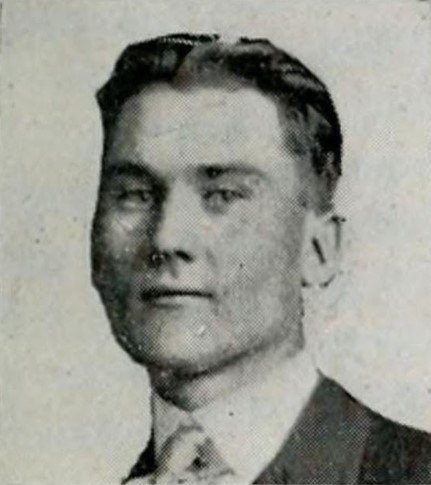
- Unit: 1st Division, 16th Infantry Regiment, 3rd Battalion, Company I
- Date of Birth: February 24, 1895
- Entered the Military: May 9, 1917
- Date of Death: July 19, 1918
- Hometown: Washington Township, Brown County, Indiana
- Place of Death: Hill 153, near Ploisy, France
- Award(s): Citation Star
- Cemetery: Plot D, Row 18, Grave 38. Oise-Aisne American Cemetery, Seringes-et-Nesles, France
Brown County High School
2018–2019
Early Life
On February 24, 1895, Aaron Ray Griffin was born to Adam A. Griffin and Sarah E. Pogue Griffin. His parents were married on August 4, 1881 in Brown County, Indiana. He was the fifth oldest in his family, with two younger siblings. Ray’s siblings were Orie Martha, Delmer, Homer, Oma, Merle, and Freida. His parents had two other children, Dora and Dale, who passed away within the first years of their lives.
The Griffin family was a prominent family in the community. Ray’s grandfather, David D. Griffin, served as the local reverend. When David Griffin passed away in 1883, Ray’s uncle William became the family figure in Brown County. Ray’s father, Adam, worked as a farmer, probably on his brother’s “fine farm” of 350 acres.
Life in Brown County during this time was centered around village life. Travel was limited by the landscape, as deeply rutted, rocky roads made travel by horseback, carriage, and wagon difficult. The first automobiles did not make their way to the area until 1913. Ray’s family lived five miles west of the county seat of Nashville, in the small village of Jackson Creek in Washington Township, near Yellowwood Lake.
During his early years, Ray attended school at Jackson Creek, a one-room schoolhouse, which was in disrepair. The teacher, Otis Downey, stated that “The roof is very poor; the stove and flew [sic] are dangerous; the house needs painting and a ventilating shaft.” Despite these conditions, at least 25 students attended school every year alongside Ray, including his younger siblings Merle and Freida, and his cousins Bonnie, Montie, and Guy.
Ray was an average student, earning his highest marks in Physiology and Scientific Temperance. He also participated in the Young People Reading Circle, reading fifteen books in one year during fifth grade. He was present at school more than absent; one year he only missed two days of school. Ray was 16 years old in the eighth grade, and did not continue on to high school. Instead, he found a career as a barber, quite possibly at E. Lane Barber Shop in Nashville, Indiana.

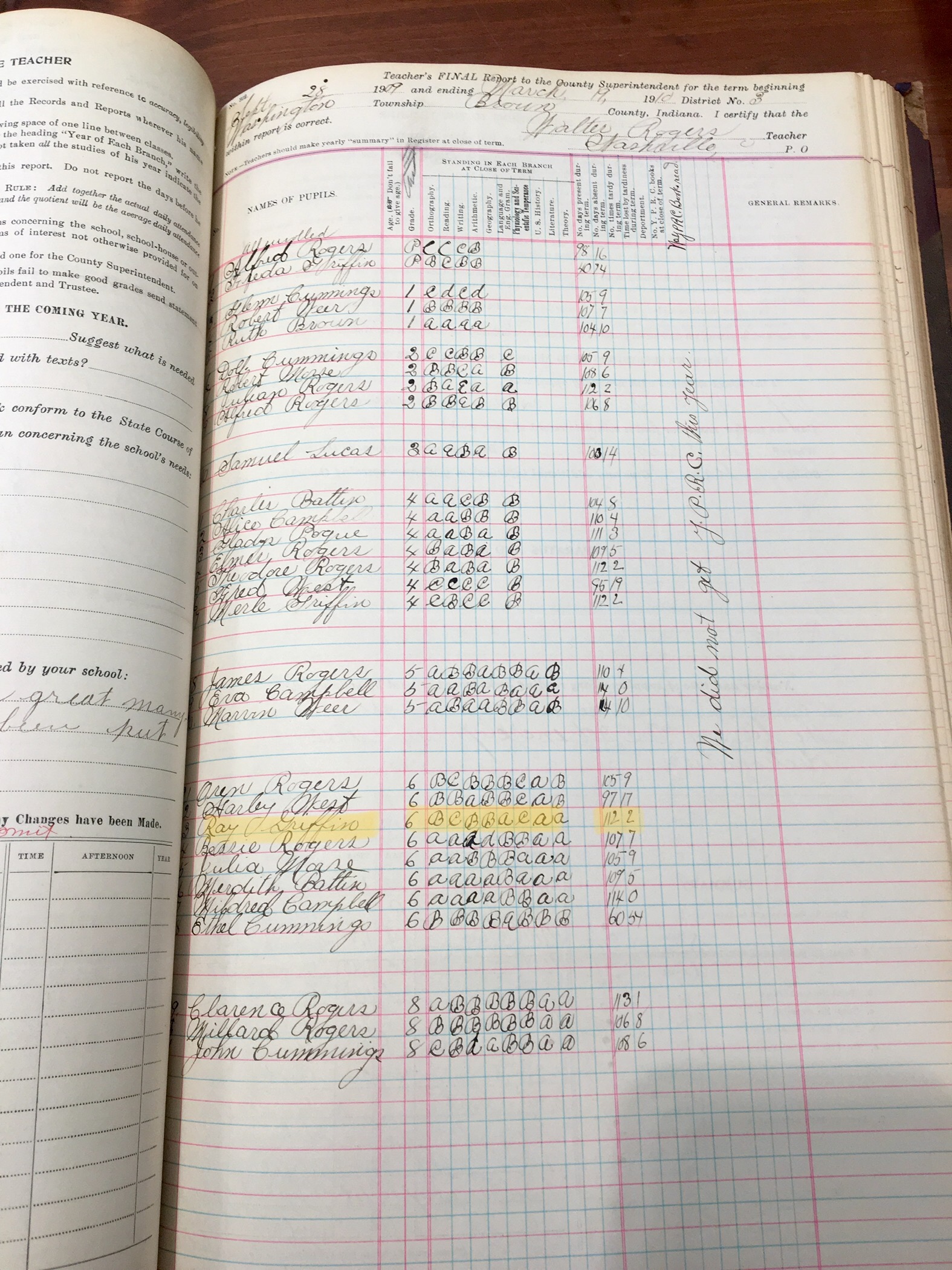
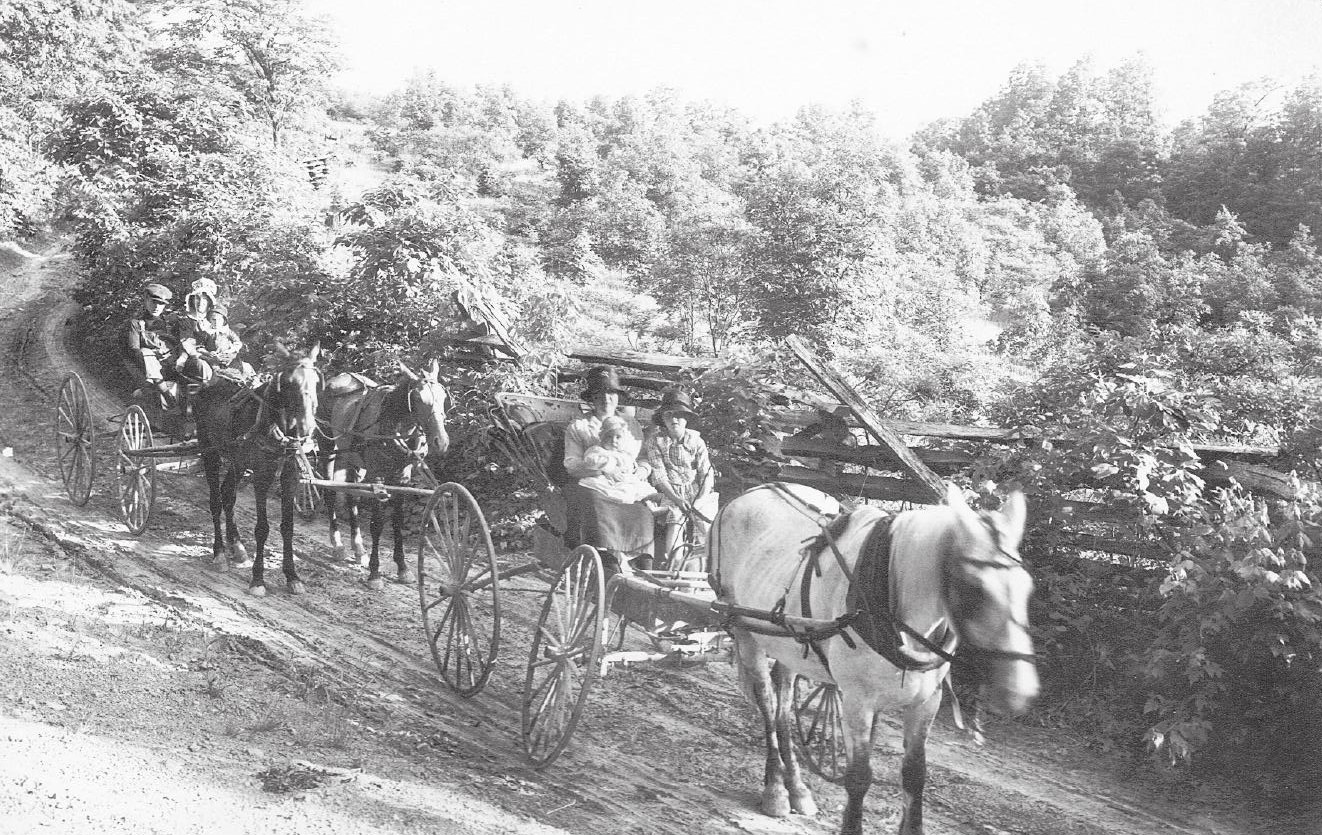
Military Experience
When the United States declared war on Germany on April 6, 1917, Griffin did not hesitate to join the effort. He enlisted in the U.S. Army on May 9, 1917. Military service was not something new to his family. His great-great grandfather served during the Revolutionary War, and his Uncle William volunteered to fight and suffered severe injuries during the Civil War.
The U.S. Army assigned Griffin to the 16th Infantry Regiment, 3rd Battalion, Company I. He enlisted at Jackson Barracks, Missouri and soon left for Camp Cotton in El Paso, Texas where he joined his regiment The regiment had been stationed at the Mexican border since 1914, trying to maintain control and stability in the wake of the raids conducted by Pancho Villa and his followers.
Shorty after he enlisted, General John “Black Jack” Pershing personally chose the 16th Infantry Regiment as one of the four regiments to make up the newly created 1st Division. Griffin and his fellow soldiers packed their bags. They travelled by train to Hoboken, New Jersey, arriving at the beginning of June.
On June 14, 1917, Griffin boarded the USS Havana and headed to France. Escorted by four cruisers, 13 destroyers, two armed yachts, and two fuel tankers, the convoy of ships had a relatively smoothly journey across the ocean. One night a number of torpedoes coursed through their convoy, two of them narrowly missing the Havana. Many of the soldiers did not notice the event, however, with one remarking “daily rumors spread that submarines were near, but no one saw them.”
The troops arrived safely on June 26, 1917, in Saint-Nazaire, France. The 16th Infantry Regiment became the first U.S. Army regiment to lay foot in the war torn country. They disembarked and took residence in what had previously been a German prisoner of war camp. There, Griffin continued his training.
In early July, the division moved to a permanent training camp at Gondrecourt-le-Château in Lorraine, France. They boarded boxcars called “forty and eights,” as they held forty men or eight horses. Although in this case, they held forty-five soldiers, along with their packs and rifles. The journey lasted ten days.
Upon arriving at Gondrecourt-le-Château, Griffin and his fellow soldiers launched into an intense training program. They spent eight hours each day, with the exception of Saturday afternoons and Sundays, learning how to fight in this new war. The French 47th Division, the Chasseurs d’Alpins, a division of the elite mountain infantry of the French Army, trained the 16th Infantry Regiment for combat.
For the next six months, Griffin mastered everything from rifle instruction to personal hygiene. He and his fellow soldiers spent time learning the operation of machine guns, grenades, and Stokes mortars, while also conducting road marches with full packs. At the end of each long, difficult day of training, Griffin and the rest of the 16th Infantry Regiment went back to makeshift homes in the barns of French farmers in surrounding villages.
Six men bunked together. The rooms had poorly fitted doors that allowed a constant draft and snow to seep in, making what little leisure time the men had uncomfortable. They slept on a stone floor with a full pack, only removing their wet shoes and socks. Their jackets served as pillows, and their shoes never completely dried.
From mid-September to mid-October 1917, Griffin’s unit began practicing warfare in a mock trench built in their training area called Washington Center. During his time training in the mock trenches, Griffin received medical treatment in the hospital. His visit lasted from October 3 to October 26. When he returned to training he did not stay long on site, as he and the 16th Infantry Regiment shipped out to the Sommerville sector of the front at the beginning of November.
Off to Battle
As a sector, Sommerville remained a relatively quiet area, which permitted the men to gain combat experience without suffering heavy casualties. While the 2nd Battalion saw deadly action, leaving three Americans dead, the 3rd Battalion of the 16th Infantry Regiment finished their first ten days in the trenches on November 20 without major incident. This was the first action of the war Griffin saw.
During the winter of 1917-18, often called the “Winter of Valley Forge,” the men faced depressingly cold and harsh conditions. Griffin experienced the harsh elements firsthand when on January 14, 1917, in the face of a blizzard, his regiment marched 40 kilometers to the Ansauville subsector in northeastern France.
The roads along the way were completely covered in ice, making it extremely difficult for the heavily laden men to keep from falling down. It was a long, horrible journey made worse by the sleet they experienced, which drenched them to the bone and increased the weight of their load. Eventually, they arrived and relieved the French forces in Ansauville from January 18 to January 21. They then remained in the subsector, providing assistance until April, when the 1st Division turned their attention to the German offensives in the west.
Montdidier Sector
On April 4, 1918, Griffin boarded a troop train and began the 310-mile journey to Chaumont-en-Vexin and Gisors, France. Once there, the 1st Division developed their skills in maneuver warfare, expecting battle in the open rather than in trenches. Just one week later, they moved to the Montdidier sector, merging with the French First Army.
On the night of April 24 to 25, the 16th Infantry Regiment occupied the right side of the front line. The unorganized French Army created a disadvantage for the 16th Infantry Regiment. Moreover, the Germans occupied the higher ground in the village of Cantigny. This empowered the enemy to fire explosive and chemical rounds against the American and French forces. The Germans created significant losses, which demoralized the inexperienced troops. The regiment suffered more than 4,700 casualties, including 1,000 dead.
One month later, the 28th Infantry Regiment launched an offensive attack against the Germans at Cantigny, defeating them and taking the village. The 16th Infantry Regiment replaced the 28th in the line from May 30 to June 1, 1918. Griffin and the rest of the 3rd Battalion occupied the front. The Germans, frustrated at their recent loss, held nothing back. One soldier wrote,
“We had a rather hard time of it here as the Germans sent over gas all of the time, so when our food finally reached us, it was all green and we had to throw it away. We spent forty-eight hours without a drink of water… As our trenches here were only fifty or sixty feet from the Germans we had a lot of fun throwing hand grenades over into the German lines and they did not spare any either.”
The 16th Infantry Regiment, along with the rest of the 1st Division, held the line for the next 72 days. Life in the trenches was not pleasant, especially when the Germans continued to test the American defenses. Griffin and his fellow soldiers found it difficult to find any opportunity to change their clothes, bathe, or delouse during this time.
On July 8, the French relieved the 1st Division. The men made their way to the village of Beauvais. For the next few days, Griffin took time to do all the things he could not do in the trenches, including catch up on sleep. This rest was short lived, however, as the 1st Division departed on July 15, 1918 to an area east of Compiègne. Little did Griffin know, this would be his last march.
Battle of Soissons
The Battle of Soissons was part of the Allied Aisne-Marne offensive. The goal was to break the enemy front and sever the German supply lines by taking the land around and to the southeast of Soissons. The American 1st and 2nd divisions, along with the French 1st Moroccan Division would lead the attack. The Allied forces hoped that if the Germans no longer had access to the road and rail line from Soissons to Château-Thierry they would be incapable of supplying their men along the Marne, driving them to retreat. Griffin and the rest of the 16th Infantry Regiment found themselves in the middle of action.
Griffin and his fellow soldiers were surprised by their role in the offensive, believing they had more time to rest. The 16th Infantry Regiment moved by truck to a position ten kilometers west of the line on the night of July 16. On July 17, Griffin marched those remaining ten kilometers along with thousands of others. The march tired the men, as they fell into shell holes, and dealt with torrential downpours along the way. As they grew closer to the impending battle, the 16th Infantry Regiment grew more determined with every step. As the regimental chaplain wrote:
“Dazed with weariness from their long hike, they pushed their way over barbed wire entanglements, past plunging artillery horses and rumbling tanks which blocked their passage, through veritable seas of mud, on and ever on through the night… Those weary bodies would straighten, the men would hitch their packs a little higher, grab their rifles a little tighter, and plunge ahead. Nothing but death would or could stop them from going over in the morning.”
On the night of July 17, Griffin and the others anxiously awaited the morning. Rain poured down upon them and lightning lit up the sky. At dawn, there was no barrage of artillery; it was to be a surprise. The silence broke as a lone red rocket shot into the air, and with that the battle commenced. At 4:35 a.m. on July 18, the 16th Infantry Regiment launched forward over the road and into the wheat fields beyond.
For the first few kilometers, the men were in high spirits. Casualties remained low and in the distance they saw German soldiers retreating. However, as they continued to advance in the wheat field they came across another surprise. The men discovered enemy machine gun nests where German artillery men lay in wait. On top of this, the 26th and 28th Infantry Regiments, tasked with protecting the advance’s left flank, experienced hard fighting, leaving the flank exposed to enemy fire. Despite these challenges, the men reached their objective, the Paris-Soissons road.
Enemy artillery focused on this location. The Americans suffered heavy losses, as every tree along the road sheltered machine gunners. Griffin and the 3rd Battalion, acting as Brigade Reserve, moved up beyond the road, support of the advance line. Here, they held the front, stopped counterattacks, and helped re-organize the line, while the 1st Battalion recovered. For a number of hours, the 1st and 3rd Battalions fought together and then advanced toward the railroad that acted as the German supply line.
The advance continued on through July 19. The 16th Infantry Regiment only gained two kilometers by 5:30 that afternoon. The 1st and 3rd Battalions dug in at a position centered on Hill 153, at the Ploisy Ravine. Griffin died here when an artillery shell exploded, shattering his skull. He was buried on the field of honor by his fellow soldiers.
The 1st Division accomplished its mission of cutting the Soissons-Château-Thierry Road and the rail line communications of the Germans on the Marne. The German commander ordered his troops to withdraw from the region.
The 16th Infantry Regiment received accolades for distinguished conduct during the battle. The division commander specifically recognized them for their “exceptional aggressiveness in advancing a battalion into the enemy’s territory without immediate support, while sustaining heavy losses…”
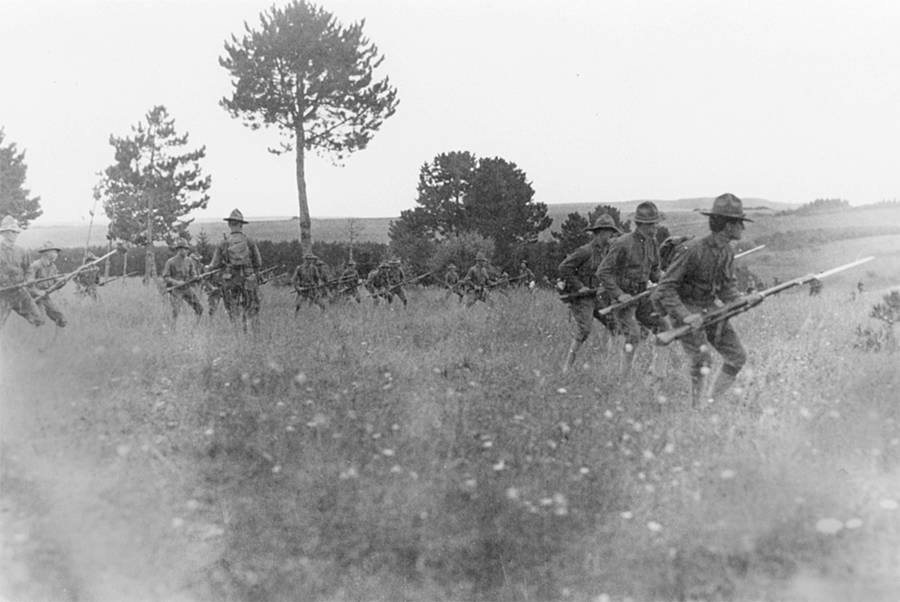

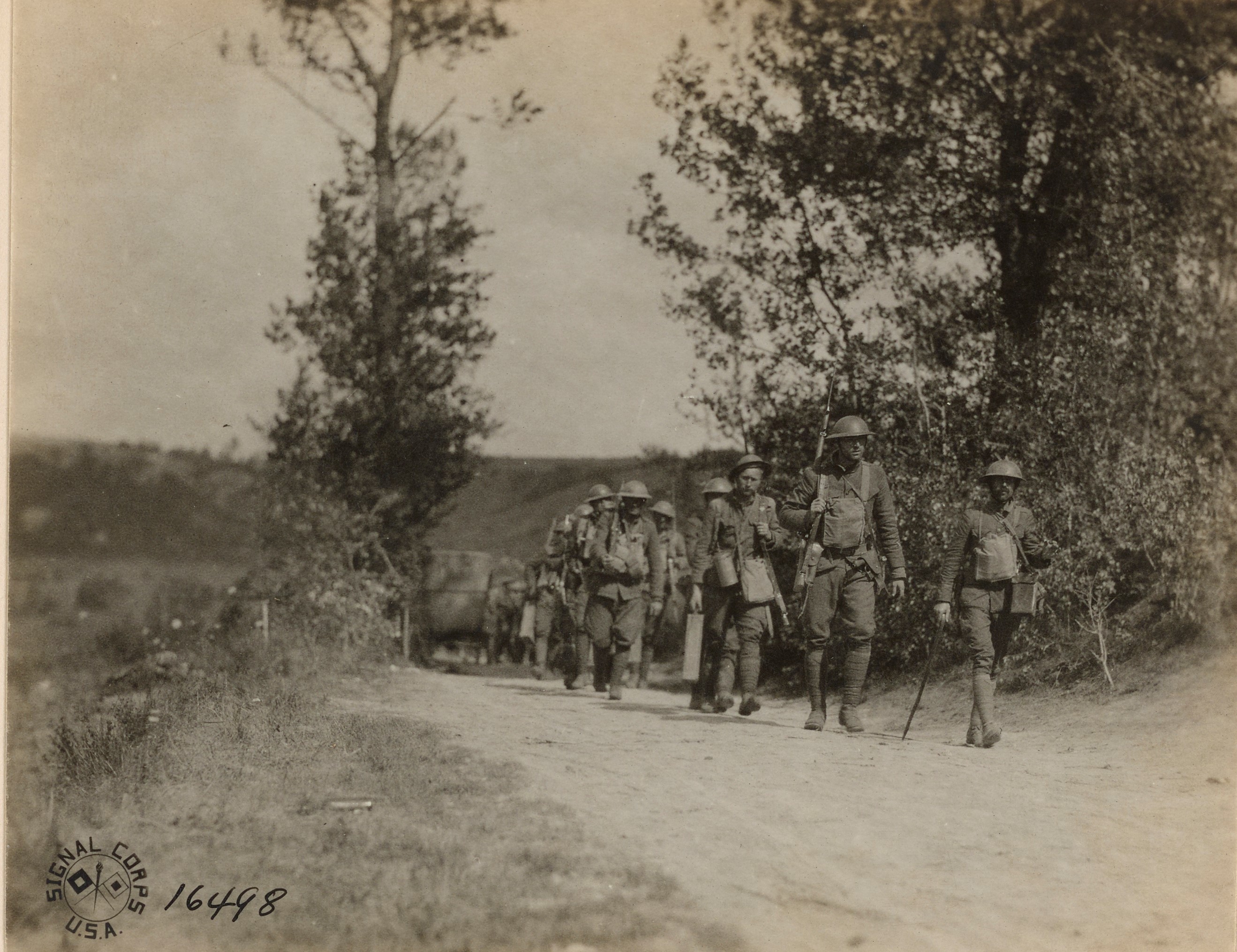
Eulogy
According to Griffin’s close friend, Sergeant Walter Howard, Griffin was “a gallant soldier who was highly esteemed by his comrades.” To honor his noble actions during the Battle of Soissons, on January 1, 1920, the U.S. Army posthumously awarded Griffin the Citation Star for gallantry in action and especially meritorious service. This award is the precursor to the Silver Star, the third highest personal decoration for valor in combat. In 2019, Griffin’s Citation Star was converted to the Silver Star.
Griffin was listed as a member of the Gold Star Honor Roll for the state of Indiana after the war ended. His service is commemorated on the Veterans Memorial in Brown County, Indiana, as well as at the local Veterans of Foreign Wars (VFW) Post. Griffin’s name is also on a monument in Buzancy, France, dedicated to the soldiers of the First Division who lost their lives near the town during World War I.
Griffin’s mother received an invitation to participate in on the Gold Star mother’s trips, traveling to France to visit her son’s final resting place. However, she declined in 1932 because of her poor health. She stated “God only knows how much I want to go, but can’t.” She declined again in 1933, as Griffin’s father was blind and in poor health. As such, she never visited her son’s grave.
Griffin’s memory never left her, however. While overseas, Griffin made a pact with his friend Walter Howard that if one of them failed to return home, the other would become a surrogate son to the mother of the fallen. Howard remained true to this pact, travelling to visit Griffin’s mother twice every year from his home in Oklahoma and later from West Lafayette, Indiana. He even sent her flowers on Mother’s Day, making sure that while Griffin could not be there, he would never be forgotten.
.jpg)
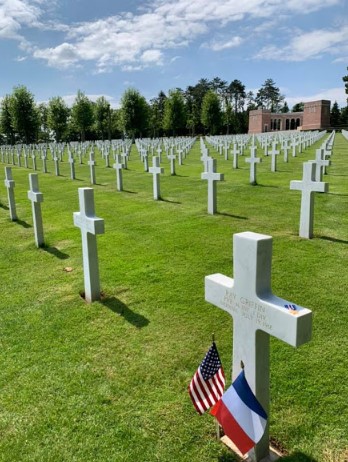
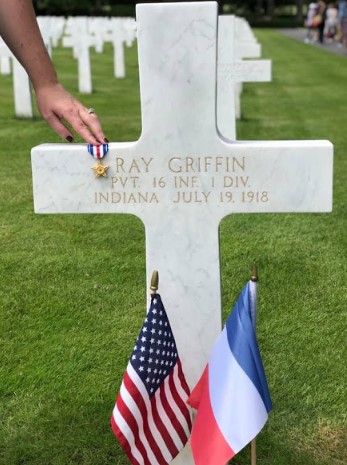
Reflection
Bibliography
1st Division; Records of Combat Divisions, 1917-1942, Records of the American Expeditionary Forces (World War I), Record Group 120 (Boxes 42-44); National Archives at College Park, College Park, MD.
16th Infantry Regiment troops resting at Couvres-et-Vaisery, France. Photograph. JJuly 18, 1918. 16th Infantry Regiment Association. Image.
Bailey, Dorothy. “A History of Brown County.” Brown County Historical Society. Accessed January 4, 2019. www.browncountyhistorycenter.org/brief-history-of-brown-county.html.
Bayonet Training at Gondrecourt, France. Photograph. July 30, 1917. 16th Infantry Regiment Association. Image.
“Biographical Sketches Washington Township and Nashville Brown County Indiana.” Genealogy Trails History Group. Last modified 2019. Accessed January 15, 2019. genealogytrails.com/ind/brown/bios1.html.
“Brown County, Indiana Populations.” World Population Review. Updated 2018. Accessed January 15, 2019. worldpopulationreview.com/us-counties/in/brown-county-population/.
Brown County, Indiana School Records. Brown County Historical Society.
Challenges of Travel in Brown County, Indiana. Photograph. 1914. Brown County Historical Society. Image.
Clay, Steven. Blood and Sacrifice: The History of the 16th Infantry Regiment from the Civil War through the Gulf War. Wheaton, Illinois: Cantigny First Division Foundation, 2001.
Company I Muster Rolls. Courtesy of the 16th Infantry Regiment Association.
General Orders Awarding Ray Griffin the Citation Star. Courtesy of the 16th Infantry Regiment Association.
“History of the 16th Regiment.” Sixteenth Infantry Regiment Association. Last modified 2017. Accessed January 4, 2019. 16thinfassn.org/history/regimental-history/.
Indiana. Brown County. 1880 U.S. Census. Digital Images. ancestry.com.
Indiana. Brown County. 1900 U.S. Census. Digital Images. ancestry.com.
Indiana. Brown County. 1910 U.S. Census. Digital Images. ancestry.com.
Indiana Historical Commission. Gold Star Honor Roll. Indianapolis: Fort Wayne Printing Company, 1921.
Longacre, Private. Men of the 1st Division making chalk crosses…Bonvillers, France. Photograph. May 7, 1918. National Archives and Records Administration (111-SC-13135-ac). Image.
Map of Brown County, Plan of Nashville, 1876. Map. 1876. Indiana Historical Society (G1400_I55_1876_139). images.indianahistory.org/cdm/singleitem/collection/p16797coll20/id/67/rec/2.
Pamphlet of Business. Brown County Historical Society.
“Ray Griffin.” American Soldiers of World War I. Digital Images. ancestry.com.
Ray Aaron Griffin, World War I Burial Case File and VA Master Index Card; Correspondence, Reports, Telegrams, Applications and Other Papers relating to Burials of Service Personnel, Records of the Quartermaster General’s Office, 1915-1935, Record Group 92; National Archives and Records Administration – St. Louis.
Regimental Chaplain. The Story of the Sixteenth Infantry in France. Montabour-Frankfurt: Office Martin Flock, 1919.
“Remembering World War I: American Troop Ships first Arrive in France.” American Battle Monuments Commission. Updated June 26, 2017. Accessed May 6, 2019. abmc.gov/news-events/news/remembering-world-war-i-american-troop-ships-first-arrive-france.
“U.S. Army Order of Battle.” Washington, D.C.: Government Printing Office, 1914. World War I Document Archive: Brigham Young University. Accessed January 5, 2019. wwi.lib.byu.edu/index.php/U.S._Army_Order_of_Battle.
Wheeler, James Scott. The Big Red One: America’s Legendary 1st Infantry Division. Lawrence: University of Kansas Press, 2017.
“William Griffin.” American Civil War Soldiers. Digital images. ancestry.com.

